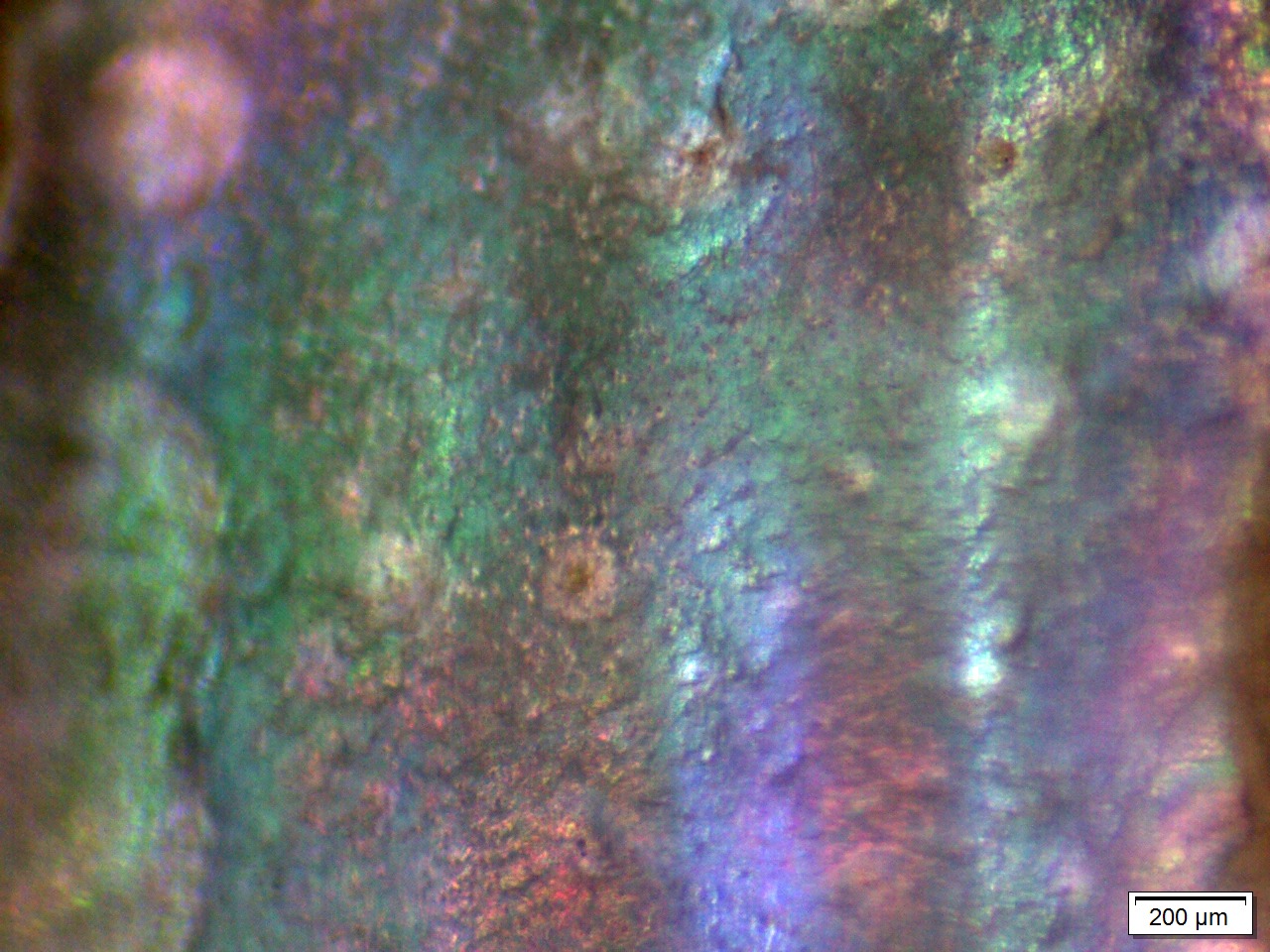Abstract
Colour arises most prominently in the world from subtractive processes. For instance, if a material is dyed with a pigment, when a light is shone upon it, the pigment absorbs portions of the electromagnetic spectrum that the base material does not. This translates directly into a colour, that is, our eye’s interpretation of one small portion of the electromagnetic spectrum, known as the visible spectrum (which are waves with a wavelength between 380 – 780 nanometers). For example, in general (though with some notable exceptions) leaves are green because the chlorophyll in them strongly absorbs the red and blue portions of the spectrum, leaving the green to be reflected, irrespective of factors such as viewing angle. It is interesting to recognize that the colour we assign to an object is in fact the colour which is ‘rejected’ by the material composition, as opposed to anything ‘accepted’ by it.
This concept of subtractive colour is so ubiquitous in printmaking that it doesn’t often merit discussion. Subtractive colour pigments are the de facto method of colouration because they are widely accessible, easily manufactured and, most of all, cheap. However, as manufacturing methods become more complex and these pigments in turn become more accessible, we can begin to imagine colouration that is far more complex.
References
Kjernsmo, K., Whitney, M., Scott-Samuel, N.E., Hall, J.R., Knowles, H., Talas, L. and Cuthill, I.C., 2020. Iridescence as Camouflage. Current Biology, 30(3), pp.551-555.
Schenk, F., Wilts, B. D. and Stavenga, D. G., 2013. The Japanese jewel beetle: a painter’s Bioinspiration biomimetics, 8(4), p.045002.
Schenk, F., 2015, March. Biomimetics, color, and the arts. In Bioinspira- tion, Biomimetics, and Bioreplication 2015 (Vol. 9429, p. 94290Z). Inter- national Society for Optics and
Ripley, L. and Bhushan, B., 2016. Bioarchitecture: bioinspired art and architecture—a perspective. Philosophical Transactions of the Royal Society A: Mathematical, Physical and Engineering Sciences, 374(2073), p.20160192.
Young, , 1804. Experimental demonstration of the general law of the in- terference of light. Philosophical Transactions of the Royal society of Lon- don, 94(1804), p.1.
Sun, J. and Bhushan, B., 2012. Structure and mechanical properties of beetle wings: a review. Rsc Advances, 2(33), 12606-12623.
Onelli, O.D., van de Kamp, T., Skepper, J.N., Powell, , dos Santos Rolo, T., Baumbach, T. and Vignolini, S., 2017. Development of structural colour in leaf beetles. Scientific reports, 7(1), pp.1-9.
Arwin, , Del R ́ıo, L.F. and J ̈arrendahl, K., 2014. Comparison and analysis of Mueller-matrix spectra from exoskeletons of blue, green and red Cetonia aurata. Thin Solid Films, 571, pp.739-743.
Pasteels, J.M., Deparis, O., Mouchet, S.R., Windsor, D.M. and Billen, J., 2016. Structural and physical evidence for an endocuticular gold reflector in the tortoise beetle, Charidotella Arthropod structure development, 45(6), pp.509-518.
Toivonen, S., Onelli, O.D., Jacucci, G., Lovikka, V., Rojas, O.J., Ikkala, O. and Vignolini, S., 2018. Anomalous-Diffusion-Assisted Bright- ness in
White Cellulose Nanofibril Membranes. Advanced Materials, 30(16), p.1704050.
Arwin, , Mendoza-Galv ́an, A., Magnusson, R., Andersson, A., Landin, J., J ̈arrendahl, K., Garcia-Caurel, E. and Ossikovski, R., 2016. Structural circular birefringence and dichroism quantified by differential decomposi- tion of spectroscopic transmission Mueller matrices from Cetonia aurata. Optics letters, 41(14), pp.3293-3296.
Snow, M.R., Pring, A., Self, , Losic, D. and Shapter, J., 2004. The origin of the color of pearls in iridescence from nano-composite structures of the nacre. American mineralogist, 89(10), pp.1353-1358.
Zhang, W. and Zhang, G., 2017. Dynamic structural color in the nacre of Hyriopsis Cumingii and its Optik, 135, pp.252-255.
Tan, L., Wong, D. and Lee, P., 2004. Iridescence of a shell of mollusk Haliotis Glabra. Optics express, 12(20), pp.4847-4854.
Shawkey, D. and Hill, G.E., 2005. Carotenoids need structural colours to shine. Biology Letters, 1(2), pp.121-124.
Stoddard, M.C. and Prum, R.O., 2011. How colorful are birds? Evolution of the avian plumage color Behavioral Ecology, 22(5), pp.1042-1052.
Stavenga, G., Leertouwer, H.L. and Wilts, B.D., 2018. Magnificent mag- pie colours by feathers with layers of hollow melanosomes. Journal of Ex- perimental Biology, 221(4), p.jeb174656.
Freyer, Wilts, B.D. and Stavenga, D.G., 2019. Reflections on iridescent neck and breast feathers of the peacock, Pavo cristatus. Journal of the Royal Society Interface Focus, 9(1), p.20180043.
Sardar, S., Wojcik, , Kang, E.S., Shanker, R. and Jonsson, M.P., 2019. Structural coloration by inkjet-printing of optical microcavities and meta- surfaces. Journal of Materials Chemistry C, 7(28), pp.8698-8704. Liu, Y., Wang, , Ho, J., Ng, R.C., Ng, R.J., Hall-Chen, V.H., Koay, E.H., Dong, Z., Liu, H., Qiu, C.W. and Greer, J.R., 2019. Structural color three- dimensional printing by shrinking photonic crystals. Nature commu- nications, 10(1), pp.1-8.
Zhao, Y., Xie, Z., Gu, H., Zhu, C. and Gu, Z., 2012. Bio-inspired variable structural color Chemical Society Reviews, 41(8), pp.3297-3317. Liang, H.L., Bay, M., Vadrucci, R., Barty-King, C.H., Peng, J., Baum- berg, J.J., De Volder, M.F. and Vignolini, S., 2018. Roll-to-roll fabrication of touch-responsive cellulose photonic laminates. Nature communications, 9(1), pp.1-7.
Maile, F.J., Pfaff, G. and Reynders, , 2005. Effect pigments—past, present and future. Progress in organic coatings, 54(3), pp.150-163.
Sˇtengl, , Sˇubrt, J., Bakardjieva, S., Kalendova, A. and Kalenda, P., 2003. The preparation and characteristics of pigments based on mica coated with metal oxides. Dyes and Pigments, 58(3), pp.239-244.
Marks, A. (2012). Japanese Woodblock Prints: Artists, Publishers and Masterworks: 1680-1900. Tuttle
Tinschert, J., Zwez, D., Marx, R., Anusavice, K. J. (2000). Structural reliability of alumina-, feldspar-, leucite-, mica-and zirconia-based ceramics. Journal of dentistry, 28(7), 529-535.
Parker, R., 2000. 515 million years of structural colour. Journal of Optics A: Pure and Applied Optics, 2(6), p.R15.

This work is licensed under a Creative Commons Attribution 4.0 International License.
Copyright (c) 2020 Damien Leech
